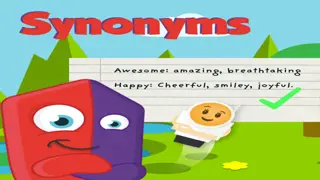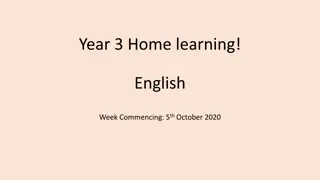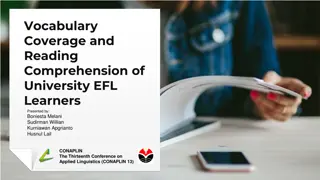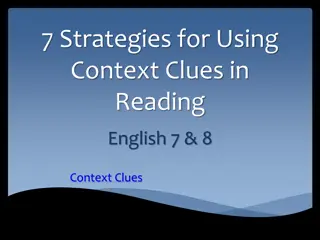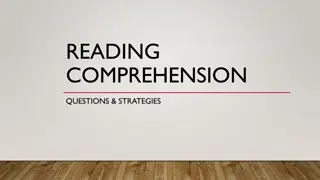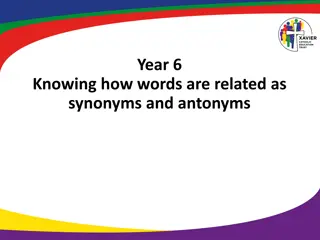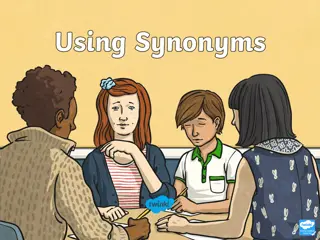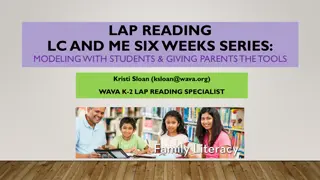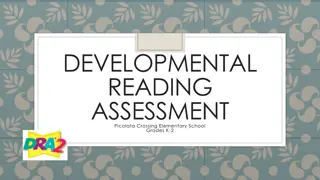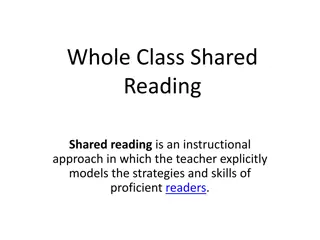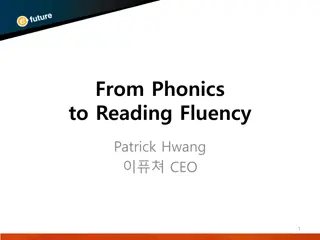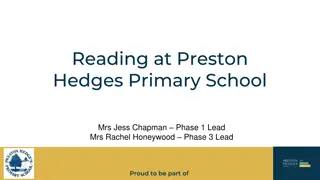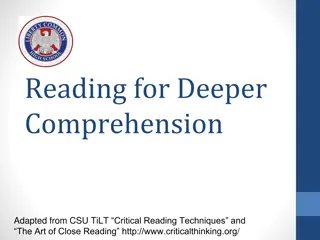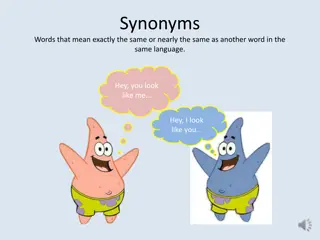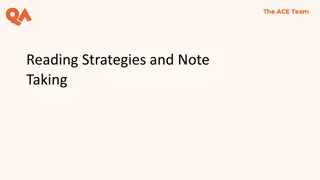Understanding Mathematics Through Reading Comprehension and Synonyms - English for Mathematics Week 8
In Week 8 of English for Mathematics, students delve into reading comprehension, focusing on the presentation of mathematical concepts. They engage in reasoning, problem-solving, and theorem proving, enhancing their understanding of theory and application. Additionally, they explore synonyms related to experiments, testing, and trials, aligning mathematical concepts with real-world scenarios and language usage.
Download Presentation

Please find below an Image/Link to download the presentation.
The content on the website is provided AS IS for your information and personal use only. It may not be sold, licensed, or shared on other websites without obtaining consent from the author. Download presentation by click this link. If you encounter any issues during the download, it is possible that the publisher has removed the file from their server.
E N D
Presentation Transcript
English for mathematics Week 8, 23. 11. 2021.
Content The first quarter: reading comprehension, texts: Presentation, synonyms, Points and lines The second quarter: grammar, gerund: ING forms, indefinite pronouns The third quarter: discussion about relevant topics: formulation of research questions The fourth quarter: basic rules for the COVER LETTER writing
The first quarter: the reading comprehension: the text - Presentation There is much thinking and reasoning in maths. Students master the subject matter not only by reading and learning, but also by proving theorems and solving problems. The problems therefore are an important part of teaching, because they make students discuss and reason and polish up on their own knowledge. To understand how experimental knowledge is matched with theory and new results extracted, the students need to do their own reasoning and thinking. (Phuong: 2003: 34 )
The first quarter: the reading comprehension: the text Presentation: synonyms for the word experiment: what is the difference between the following words= Experiment Testing Trial https://matf.webex.com/matf/e.php?MTID=mfa7c07a1744d43b81df2dc5733f827 Trial run Test Piloting
Experiment synonyms. Test - process that is used to finding out important information about something, whether machine works properly, or whether someone has an illness An example: A blood test will show if you are a possible bone marrow donor. Experiment a scientific test to find out how something is affected when you do something to it. Trial a test in which a new product, such as drug, or a weapon, or a vehicle is used by a small number of people in order to find out if it is safe and effective. An example: Until now, the drug was only available to people taking part in clinical trials.
Experiment: synonyms: Experiment: synonyms Testing - Trial run an occasion when you test a new method or system to see whether it works well An example: The national railroad is doing a few trial runs to test new equipment. Pilot test in which a new idea or plan is used in a limited number of places or situations, to see if it is worth continuing or doing in a more general way An example: The government sponsored a pilot project to find out how the education reforms work in schools Piloting a process in which a new system or product is tested using differennt groups in order to see how effective and popular it will be. An example: Extensive piloting has shown us our study book will be a useful aid to students.
The first quarter: verb think synonyms Two classes: To have a particular opinion To think that something is, but you are not sure.
The first quarter: synonyms the first class: to have a particular opinion Think Believe Figure Reckon Consider Think of somebody or something
The second quarter: synonyms the first class: to have a particular opinion Believe Assume Suspect Presume (the key to be found in the next slide)
The first quarter: synonyms for think: have particular opinion Think of to think that somebody or something is a particular kind of person or thing. Especially when your though is unfair Figure American. to develop an opinion about situation after considering it carefully. The operation went fine, and they figure he ll be Regard/see- Reckon chiefly British to have a particular opinion about something or someone. Example: They reckon the French team better than ours. To regard/see- to think that someone or something is of particular kind or thing. Example: America was seen as the land of opportunity Recognize To take the view that to decide to have a particular opinion especially when other opinions are different. Example:
The first quarter: synonyms for think: have particular opinion Assume to think that something is true, although you have no proof Example 1: I think we can safely assume that practice is legal Presume - to be fairly sure of something, especially, because you have good reason to think, although you have no proof Example2: Many scientists presumed that the new damage to the forests to be the result of the higher levels of pollution Suppose to think that something is probably true, especially because you have good reason to think so Example 3: There are many reasons to suppose that Shakespeare was familiar with the stories of medieval Italy
The first quarter: synonyms for think: have particular opinion Assume reasonably, safely assume (not well assume Phrase: be reasonable, be fair, be safe to assume Presume rightly, wrongly, automatically, reasonably, conclusively presume
The first quarter: the second paragraph: reading comprehension Geometry is a very old subject. It probably began in Babylonia and Egypt. Men needed practical ways, as the knowledge of the Egyptians spread to Greece, the Greeks found the ideas about geometry very intriguing and mysterious. The Greeks began to ask Why? Why is that true? . In 300 B.C all the known facts about Greek geometry were put into a logical sequence by Euclid.
The first quarter: the second paragraph: reading comprehension (reading the text) The world around us contains many physical objects from which mathematics has developed geometric ideas. These objects can serve as models of the geometric figures. The edge of a ruler, or an edge of this page is a model of a line. We have agreed to use the word line to mean straight line. A geometric line is the property these models of lines have in common; it has length but no thickness and no width; it is an idea. A particle of dust in the air or a dot on a piece of paper is a model of a point. A point is an idea about an exact location; it has no dimensions
The first quarter: the second paragraph: reading comprehension word dimension: nonmathematical contexts Side Dimension Factor Element Feature
The word dimension: disambiguation: mathematical context. . Mathematical context (Dimension) Dimension is the number of coordinates needed to specify a point on the object. For example, a rectangle is two-dimensional, while a cube is three-dimensional. The dimension of an object is sometimes also called its "dimensionality . Nonmathematical context: Dimension a part of the situation that makes you look at the particular situation Mark the difference between the two expressions! You are supposed to make cleasr difference between mathematical and nonmathematical contexts in yours second midterm.
The first quarter: the second paragraph: the word dimension and its synonyms : nonmathematical contexts Dimension a part of the situation that makes you look at the particular situation Example: The political dimensions of the incident are clear. Factor one of parts or features of a situation, each of which has a different effect or importance The issue of abortion rights is obviously not the only factor affecting the female s vote. Side- one part of a situation or someone s character use especially when your are comparing one part with another.
The first quarter: the second paragraph: reading comprehension (reading the text) His book, called Elements, is one of the most famous books of mathematics. In recent years, men have improved on Euclid s work. Today geometry includes not only the shape and size of the earth and all things on it, but also the study of relations between geometric objects. The most fundamental idea in the study of geometry is the idea of a point and a line.
The first quarter: the second paragraph: the word line mathematical and non mathematical contexts Line (nonmathematical contexts) a long, think, continuous mark or line Line (mathematical context) - When geometry was first formalised by Euclid the Elements , he defined a general line (straight or curved) to be "breadthless length" with a straight line being a line "which lies evenly with the points on itself, However, todaz these definitions serve little purpise
The first quarter: dimension disambiguation between 1) mathematical 2) nonmathematical contexts Non-mathematical context: Dimensions the height,width, and length of an object Example: What are the dimensions of dining-room table? Mathematical context: In physics and mathematics, the dimension of a mathematical space (or object) is informally defined as the minimum number of coordinates needed to specify any point within it Thus a line has a dimension of one (1D) because only one coordinate is needed to specify a point on it for example, the point at 5 on a number line. Asurface such as a plane or the surface of a cylinder or sphere has a dimension of two (2D) because two coordinates are needed to specify a point on it for example, both a latitude and longitude are required to locate a point on the surface of a sphere. The inside of a cube , a cylinder or a sphere is three dimensional(3D) because three coordinates are needed to locate a point within these spaces
The first quarter: the word idea disambiguation between 1) mathematical 2) nonmathematical contexts: specification an idea or set of ideas that explain something Theory Hypothesis Premise Notion Concept Idea Assumption
The first quarter: the word idea synonyms Idea a way of explaining something about life and society Example: Do you generally agree with Marx s ideas? Notion way of explaining something about life, society, etc, that people often think is little stupid and old-fashioned Example 1Many widely held notions about crime have come from the cinema, magazines or novesls. Example 2: Humans still hold on to the absurd notions that we are the only intelligent beings in the universe Concept: Someone s idea of how something is done Example: what is your concept of an ideal society? Hypothesis: An idea that is based on very few facts that you cannot be sure is right.
Disambiguation: hypothesis, theory (mathematical and nonmathematical contexts) Mathematical context: In mathematics, a hypothesis is an unproven statement which is supported by all the available data and by many weaker result Mark the difference between the mathematical and nonmathematical context of the word: hypothesis In nonmathematical contexts it has a meaning of weaker assumption. Example: Various hypotheses re possible regarding Ravenusa s death.
The first quarter: reading comprehension: the text 3 The world around us contains many physical objects from which mathematics has developed geometric ideas. These objects can serve as models of the geometric figures. The edge of a ruler, or an edge of this page is a model of a line. We have agreed to use the word line to mean straight line. A geometric line is the property these models of lines have in common; it has length but no thickness and no width; it is an idea. A particle of dust in the air or a dot on a piece of paper is a model of a point. A point is an idea about an exact location; it has no dimensions. We usually use letters of the alphabet to name geometric ideas. For example, we speak of the following models of point as point A, point B and point C.
The first quarter: reading comprehension: the text 3 Some problems raise general questions which discussion of, can do much to advance your understanding of particular points of the theory. Such general questions ask for opinions as well as reasoning; they obviously do not have a single, unique or completely right answer. More than that, the answers available are sometimes misleading, demanding more reasoning and further proving. Yet, thinking your way through them and making your own choices of opinion and then discussing other choices is part of a good education in science and method of teaching.
Correct the false sentences. a. A point is an idea about any dot on a surface. b. A point does not have exact dimension and location. c. We can easily measure the length, the thickness and the width of a line. d. A line is limited by two endpoints. e. A line segment is also a subset of a line. f. Although a ray has an endpoint, we cannot define its length.
The second quarter: grammar gerund. The use of gerund with No constructions Find out what your groupmates favourite activities are. No is often used with a gerund to say that something is not allowed. NO SMOKING NO PARKING NO WAITING
The second quarter: grammar gerund. The use of gerund with No constructions Form Active Passive Non-perfect I like reading. Nobody likes being thought a fool. Perfect He admitted having made the same mistake. He denied having been criticized by his colleagues. 1. After the verbs want, need, deserve, require and the adjective worth the gerund is used in its active form though it is passive in the meaning. E.g. The film is worth seeing. 2. After the verbs excuse, forgive, remember, thank and after the prepositions on (upon), after, without the non-perfect form of the gerund may be used to denote a prior action. An example: E.g. On seeing us he stopped and took off his hat.
The second quarter: grammar gerund O Offer using the corresponding verbs followed by a gerund using the corresponding verbs followed by a gerund ffering. ing. an apology . Make up a sentence an apology . Make up a sentence 1. A)Here s the bell. I must hurry up. My lecture is to take place up stairs. B. Forgive me for troubling you, professor. I m Paker, from the University. Do you remember promising to let me attend your lectures? Can I come now? 2. Now, I m going to dictate the last sentence. A. Listen attentively. B.Pardon my interrupting you again Would you mind repeating the preceding sentence once more? (examples taken from the Swan grammar)
The second quarter: grammar gerund O Offer using the corresponding verbs followed by a gerund using the corresponding verbs followed by a gerund ffering. ing. an apology . Make up a sentence an apology . Make up a sentence 3. A. I m going to give up athletics. I can t spend all my evenings in the gym. It takes too much time to train. B. Excuse my saying so, but I just can t understand your wanting to give it up. It s your second profession!
The second quarter: grammar gerund O Offer using the corresponding verbs followed by a gerund using the corresponding verbs followed by a gerund ffering. ing. an apology . Make up a sentence an apology . Make up a sentence 4. Protest against the following statements with a short response beginning with but. Explain thereason for your protest, using the verb to want or to need + gerund. Add another sentence to make the situation clear, if necessary.
The third quarter: research questions: Euclids five postulates Prove: To draw a straight line from any point to any other. To produce a finite straight line continuously in a straight line. To describe a circle with any centre and distance. That all right angles are equal to each other. That, if a straight line falling on two straight lines make the interior angles on the same side less than two right angles, if produced indefinitely, meet on that side on which are the angles less than the two right angles.
The third quarter: Lobachevskys Parallel Postulate Lobachevsky's Parallel Postulate. There exist two lines parallel to a given line through a given point not on the line. Research question: what did Lobachevsky prove? Outline the proof and explain its significance. What is the significance of Riemman s geometry?
The third quarter: Research questions How did Euclid influence Descartes? How did Euclid influence Newton? In which sense can we talk of universe as having the Euclidean space? In which sense can talk of the universe as having the non-Euclidean space?
The third quarter: Research questions . Space is approximately Euclidean if you restrict your observations to a small region. The term for a locally-Euclidean region is a manifold,. Prove. ( Refer to Einstein s and Michelson s experiments) ,. In the text slide, you will find props for the research question number 1.
A prop to the research question 3. Even a slow movement. It showed nothing, which made no sense to anyone. Einstein explained His former math professor Minkowski simplified Einstein's equations to a single equation (The Fundamental Equations for Electromagnetic Processes in Moving Bodies), a kind of distance formula that includes time as one of the dimensions. It looks like this: d= x2+ y2+ z2 c2 t2 . Actually it's not just the equation, but the fact that the distance defined by it is invariant the same for observers in any inertial reference frame. The Euclidean distance is not, and leads to false predictions like the variance of c . The invariance of the non-Euclidean distance (or metric), and the variance of the Euclidean metric whether time is included or not, is the proof that neither space nor spacetime is Euclidean (if time is real-valued).
The third quarter: research questions (I) . Why Did Lagrange Prove the Parallel Postulate? How useful are non-euclidean geometries in explaining the structure of crystals and nano-particles? How useful is the Riemann geometry in the theory of the General relativity? How useful is the Riemann giemetry in modelling magnetic systems (gravitational magnetic curves)?
The third quarter: research questions (II) . Einstein used Minkowski's concept (Yourgrau 2005, A World Without Time: The Forgotten Legacy of G del and Einstein, Basic Books, p 34) of spacetime to formulate his more general theory of relativity, which includes non-inertial frames of reference (Einstein 1916). General relativity predicts that light is drawn by gravity the same as everything else, even though it is massless (Einstein 1916). It is observed to be true (Solar eclipse of May 29, 1919), further confirming that space is not Euclidean.
The third quarter: discussions: How did Euclid influence Newton? Newton very deliberately modeled his approach in the Principia on that taken in Euclid's Elements. Indeed, Newton's theory of motion has much in common with a conventional axiomatic system such as Euclidean geometry. ... Note, incidentally, that Newton's laws, in their primitive form, are only applicable to point objects


